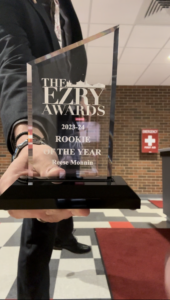The North. The six counties. Northern Ireland.
Contrary to what I thought before this semester, these different terms for the United Kingdom province that sits on the top of Ireland mean very different things. You can tell exactly what political party someone belongs to from their term for the north, and whether or not they believe Northern Ireland should still be part of the Republic.
Last week, I took a trip to Belfast with my program to study the aftermath of the troubles that erupted in the last century. I’d long known about the conflict that arose during World War I, when Ireland decided it no longer wanted to be a part of Britain. The Republicans — those in favor of the Irish Republic — launched a war of independence, while the Unionists — those in favor of remaining in the British union — opposed them. When Ireland gained its status as a Free State in 1922, the U.K. kept the six counties of Northern Ireland under British control, leaving a lot of unresolved tension in the province.
What I didn’t know about was the bloody troubles between Catholic Republicans and Protestant Unionists that erupted in 1969 and lasted until the late 1990s. Over the past seven weeks, our class has learned about the brutal violence, the abuse of civil rights protesters, the bombings of innocent civilians, and the battleground state of Belfast during the 30 years of intense conflict. However, none of this truly settled in until I met former Irish Republican Army (IRA) and Ulster Volunteer Force (UVF) volunteers.
Over 20 years after the Berlin Wall was torn down, a peace wall still runs through the center of Belfast, dividing the Protestant and Catholic areas from each other. On our tours of the Falls and Shankill roads — the historically bloodiest streets of the Catholic and Protestant areas, respectively — the peace wall rose up behind red brick houses. As the conflict continued, the government continued to build the wall taller to prevent people from throwing bombs over. Even today, you can see the bullet holes throughout the city.
“We hated the British soldiers,” said our Catholic guide of the Falls Road. He spent 10 years in prison for planting a bomb, and knew people who died in the hunger strikes of 1976. “We absolutely hated them.” His hands tensed as he told us about the brutality he experienced in the H-Blocks.
While both our Catholic and our Protestant guide expressed a desire to move past the conflict, bitterness against the other side was undoubtedly still present. On the Protestant side of city, we met up with a cheerful, older man who waved at friends he passed on the street. However, when I asked him about the policies the Northern Irish government used to discriminate against Catholics in the 1900s, he quickly became defensive.
“You need to get your facts straight,” he insisted. “That’s not how it was. Protestants were poor, too.”
Admittedly, there is still tension in Belfast. Catholic and Protestant communities and schools are still segregated, and there was a shooting near the area we toured the day after we left Belfast. However, the situation has progressed significantly. The city center no longer shuts down at 6 p.m., pubs are no longer bombed on a regular basis, and the streets are no longer a place for open warfare. Groups such as the Northern Irish Youth Forum are creating efforts to discuss and solve the issues still surrounding the community. While it may take a few generations, the Northern Ireland situation continues to move towards a solution.





